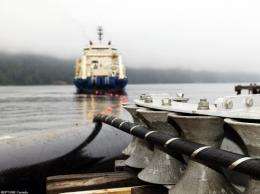The Internet comes to you across the bottom of the ocean

The Internet brings you data from around the world almost instantly. This information, coming from Geneva or Tokyo or Buenos Aires, arrives in the U.S. not from satellite but along cables that sit on the bottom of the ocean. Upgrades in many of the components that make up the vast undersea optical fiber network are about to facilitate even more speed and versatility.
The impression that satellites are modern and cables old-fashioned is wrong. Satellites are what you want to beam TV shows to customers scattered over a wide area. But if you want to dispatch lots of information from one point to another -- such as Internet information from Britain to North America -- then optical fibers are more efficient by a wide margin.
A state-of-the-art undersea fiber pair can carry about a terabit (one trillions bits) per second of data, in the form of light pulses. The pulses travel thousands of miles underwater, getting refreshed every hundred miles or so by special amplifiers built into the cable system itself.
Actually the data rate is about 10 billion bits per second for any one signal. Engineers are able to squeeze more information into a single cable by "multiplexing" up to 100 signals, each at a different frequency or color, on top of each other using a technique known as Wavelength Division Multiplexing.
Neal Bergano, a Managing Director at Tyco Telecommunications, a provider of undersea cable systems located in New Jersey, said that the signal capacity of fiber optic cables is getting ready for a large growth spurt. The multiplexing is about to get better. The devices that detect the signals emerging from the ocean are about to get more efficient.
Speaking at a meeting of optical fiber experts in March in San Diego, Calif., Dr. Bergano said that the effect of all this will be to speed up transmission in a few years by a factor 10 or more.
Compare the blazing speed of today’s signals with older transatlantic cables. The first official telegraphic message went from American President James Buchanan and Britain's Queen Victoria in 1858. The conversation lasted only a few sentences. And the line went dead after only a few days later. A decade later the lines were much better, but only bankers could afford to communicate with each other across the ocean. The price was more than $5 a word.
Undersea fiber service is about to get faster in countries that acquired high-speed telecommunications long ago. It has also just come to some nations that have never used cables before.
Bergano described an undersea network, called SEACOM, bringing terabits-per-second communications over a 15,000-kilometer network several countries in East Africa, with side branches extending to Europe and India.
Provided by Inside Science News Service

















